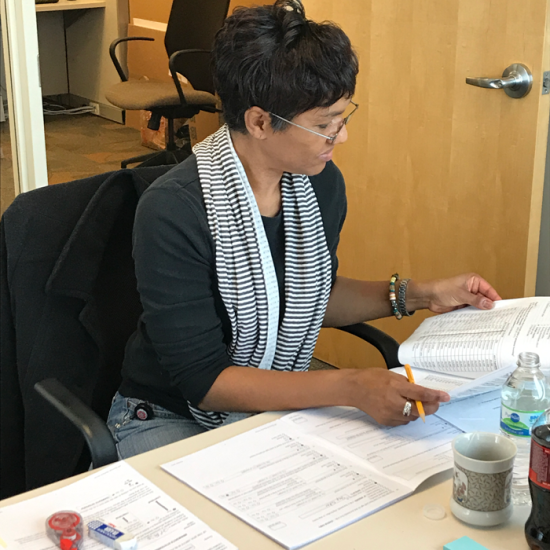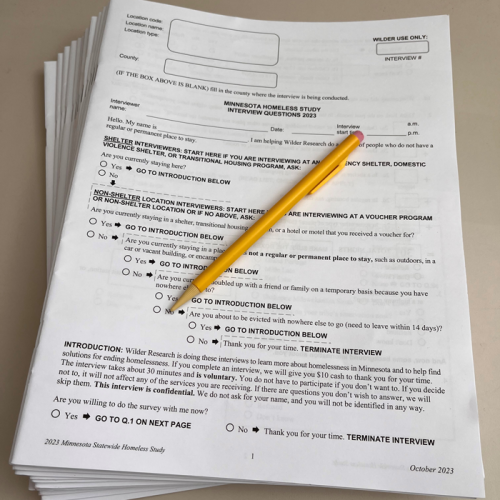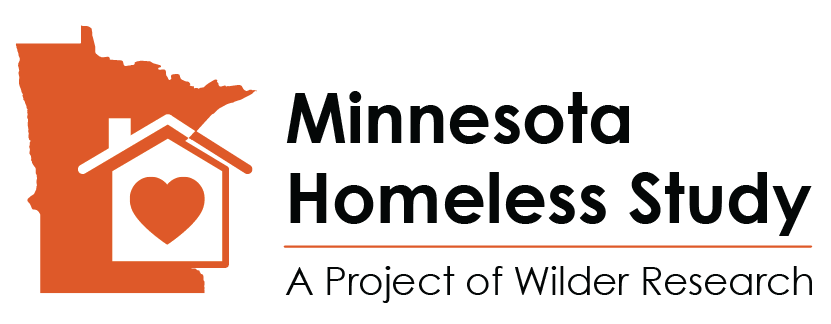
About the Study
How this point-in-time study is conducted and why it matters
The Minnesota Homeless Study is a triennial study aimed at better understanding the prevalence of homelessness in Minnesota and the circumstances of those experiencing homelessness statewide.
☰On This Page
The most recent Minnesota Homeless Study took place on October 26, 2023
Wilder Research, with the support of public and private funders, housing service providers, and volunteer interviewers, has conducted the study since 1991. Since 2006, we've partnered with six Minnesota tribal nations to conduct the Reservation Homeless Study, which looks specifically at homelessness on American Indian reservations.
Why is this study important?
The Minnesota Homeless Study is the most comprehensive source of descriptive information about the state's adults, youth, and children experiencing homelessness. Many organizations and government agencies rely on the study to: identify and address systemic issues; guide services, programs, and policies to support people experiencing homelessness; and track progress in efforts to reduce and ultimately eliminate homelessness in Minnesota.
Many years of data allow us to look at trends over time, and the breadth and depth of the study allow us to look more closely at the experiences of specific populations to pinpoint barriers to obtaining safe and stable housing.
Adults and youth who have no permanent place to live are key partners in the Minnesota Homeless Study. Their participation gives voice and substance to the reality of homelessness in our state and helps planners, funders, and advocates in their efforts to find solutions.
How we conduct the study
The study includes people who meet a federal definition of homelessness. For the Reservation Homeless Study, the study population is expanded to include those who are near homeless.
Common definitions used in the study
Federal definition of homelessness:
- People who are living in a place not meant for human habitation, in emergency shelter, in transitional housing, or are exiting an institution where they temporarily resided.
- People who are losing their primary nighttime residence, which may include a motel or hotel or a doubled up situation, within 14 days and lack resources or support networks to remain in housing. Families with children or unaccompanied youth who are unstably housed and likely to continue in that state.
- People who are fleeing or attempting to flee domestic violence, have no other residence, and lack the resources or support networks to obtain other permanent housing.
Near-homelessness: People who are temporarily staying with others (doubled up) in relatively more stable conditions.
Continuum of Care (CoC) program: Is a HUD program to promote region-wide planning and strategic use of resources to address homelessness; improve coordination and integration with mainstream resources and other programs targeted to people experiencing homelessness; improve data collection and performance measurement; and allow each community to tailor its program to the particular strengths and challenges within that community. There are 13 Continuum of Care regions in Minnesota.
Cost-burdened housing: Housing for which a household (owner or renter) spends more than 30% of their income for housing costs (rent and utilities). “Severely cost burdened” housing is housing for which the household pays more than 50% of their income.
Fair market rent: This amount, determined annually by HUD, is the value of a monthly rent payment that makes 40% (in a few locations, 50%) of local apartments available to a renter. In other words, it is the dollar amount below which 40% of the standard-quality rental housing units in the region are rented. It is used to determine payment standards for certain federal housing programs.
Food stamps: See SNAP
HUD: U.S. Department of Housing and Urban Development
Homeless shelters
- Battered women’s shelters: Safe refuge and advocacy for women and their children when fleeing an abusive situation.
- Emergency shelter: A safe place to sleep, generally open only evenings and overnight. May provide meals, housing information, and other services.
- Transitional housing: Time-limited, subsidized housing that involves working with a professional to set and address goals to become self-sufficient.
Permanent supportive housing: Affordable, long-term, community-based housing with support services for people with multiple barriers to getting and keeping housing. Because permanent supportive housing is not temporary, its residents do not fit the definition of homelessness and are not included in the statewide survey.
Point-in-Time (PIT) count: A count of sheltered and unsheltered homeless persons on a single night in January. HUD requires that Continuums of Care conduct an annual count of homeless persons who are sheltered in emergency shelter, transitional housing, and Safe Havens on a single night. Continuums of Care also must conduct a count of unsheltered homeless persons every other year (odd numbered years). Each count is planned, coordinated, and carried out locally.
SNAP (formerly known as Food Stamp program): The Supplemental Nutrition Assistance Program (SNAP) is a federal nutrition assistance program. The program provides benefits to eligible, low-income individuals and families.
Social Security Disability Insurance (SSDI) is for people who have worked and paid into the Social Security system enough to have earned coverage under their disability insurance program. You can get the benefit if you have this work history and then become blind or disabled, or if you are the spouse or child of someone who has. It can also be for adults who have been disabled since childhood, if they are otherwise eligible. Like regular Social Security, the amount of benefit you get is based on how much you paid into the system when you were working.
Supplemental Security Income (SSI): Federal program that gives monthly cash benefits if you or a child are disabled or blind, have low income and assets, and meet the other eligibility requirements. You have to go through a complicated application process to prove the disability. The monthly payment varies depending on your other income and resources. You do not have to have paid into the Social Security system to qualify for SSI.
WIC: The Special Supplemental Nutrition Program for Women, Infants, and Children (WIC) provides Federal grants to States for supplemental foods, health care referrals, and nutrition education for low-income pregnant, breastfeeding, and non-breastfeeding postpartum women, and to infants and children up to age five who are found to be at nutritional risk.
The study includes two primary methods of data collection:
- Face-to-face interviews with people experiencing homelessness (statewide and reservation studies)
- A count of people experiencing homelessness (statewide study only)
Wilder Research works closely with homeless service providers to get counts of all people staying in shelter settings on the night of the study, and to help coordinate face-to-face interviews with those staying at these shelters. Wilder also partners with service providers and homeless outreach workers to conduct interviews at drop-in service locations and to conduct street outreach.
Trained volunteers conduct interviews.
More than 1,000 volunteer interviewers conduct interviews in 400 locations across Minnesota. Wilder Research staff provide training to interviewers in preparation for the study. More than 4,000 interviews are done with people experiencing homelessness; respondents who complete an interview are given $10 cash as a thank you for participating.
About the Survey Instrument
An extensive instrument is used to conduct interviews.

Questions have been identified by housing advocates, policymakers and state planners, funders, and researchers who develop the study.
Where possible, standard questions are used that have been tested elsewhere.
Permission to download and copy this instrument is granted only for private, non-commercial and educational purposes. All reproductions of the instrument or its individual questions require an acknowledgement of the source and author of the work. No resale use may be made of any report without written permission.
Suggested Citation
Wilder Research. (2023). Minnesota Homeless Study interview questions. https://www.wilder.org/wilder-research/research-library/minnesota-homeless-study-interview-questions-2023
How the study is funded
Thank you to the institutions and individuals that have contributed to the success of the study!
The Minnesota Homeless Study is supported through a combination of grants, contracts, and individual contributions. Partnerships like these make the study the valuable resource it is.
Additional data sources
Other sources of information that complement our understanding of homelessness
An annual point in time (PIT) count of “sheltered and unsheltered homeless persons on a single night during the last ten days in January,” required by the U.S. Department of Housing and Urban Development (HUD)
The Homeless Management Information System (HMIS), which includes client information compiled by all providers of federal- and state-funded supportive housing and emergency shelter
